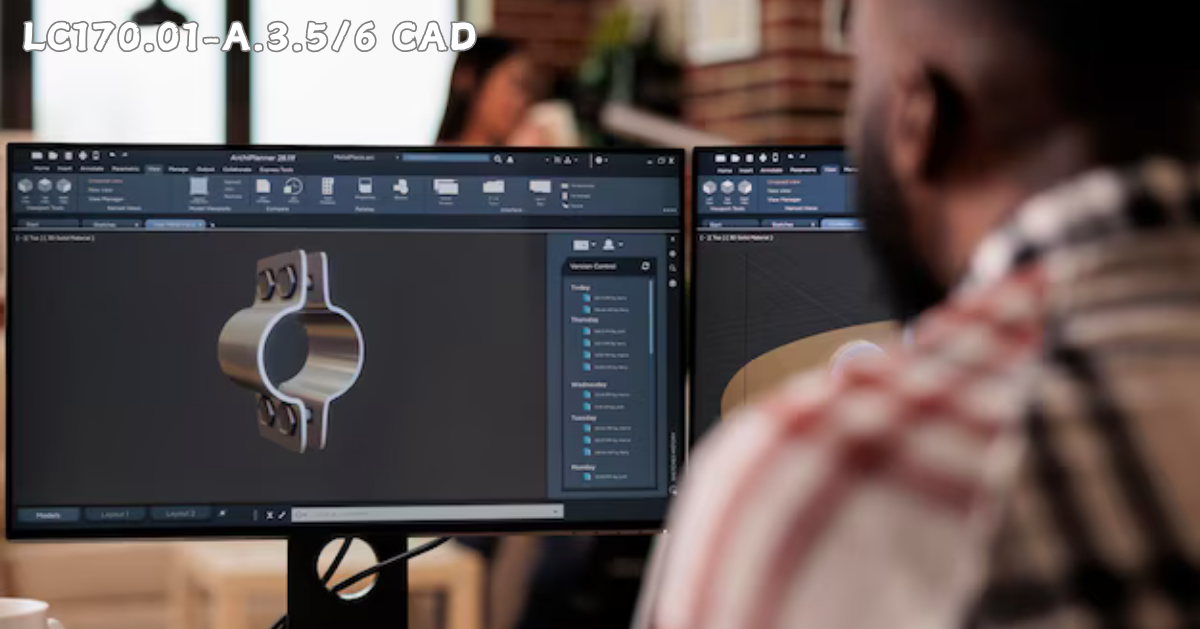When diving into the world of CAD (Computer-Aided Design), you may come across various model numbers, standards, and designations that represent different types of files, components, and configurations. One such designation that often sparks curiosity is LC170.01-A.3.5/6 CAD. Whether you’re an experienced designer or someone just starting to explore CAD technologies, understanding the meaning and applications of this specific file or component can be crucial. In this article, we’ll break down everything you need to know about LC170.01-A.3.5/6 CAD and its relevance in the design world.
What is LC170.01-A.3.5/6 CAD?
LC170.01-A.3.5/6 CAD refers to a specific file or a model used in CAD software, typically involving mechanical, electrical, or architectural design. This designation likely corresponds to a component or configuration within a particular industry standard or technical specification. The “LC” could represent a part number or a series of components designed for precise engineering or design purposes. Understanding these file types can be important when collaborating with engineers, architects, or designers who rely on CAD to visualize their projects.
Importance of CAD in Modern Design
CAD software has revolutionized the design process in multiple industries, from architecture to automotive engineering. It allows designers and engineers to create 2D drawings, 3D models, and simulations to test products before they are manufactured. CAD tools enhance precision, reduce human error, and streamline collaboration by providing a visual and editable blueprint of the product or structure. In this context, understanding the nuances of file types like LC170.01-A.3.5/6 CAD ensures that you’re working with the correct models and specifications in the design process.
Features of LC170.01-A.3.5/6 CAD Files
While specific details about LC170.01-A.3.5/6 CAD files might vary depending on the software or platform used, certain features are common across CAD files:
Precision: CAD files, including LC170.01-A.3.5/6, are known for their high level of precision. This ensures that the final product matches the design specifications to the highest degree.
Layered Design: CAD files allow for the use of layers, which means that different aspects of the design (e.g., structural elements, electrical wiring, or plumbing) can be handled separately for better clarity and management.
Scalability: CAD models, including LC170.01-A.3.5/6, can be easily scaled. Designers can create both small-scale models for prototypes and full-scale representations for construction.
3D Visualization: Modern CAD software enables users to generate 3D models from LC170.01-A.3.5/6 CAD files, providing a more accurate and comprehensive view of the final product.
Applications of LC170.01-A.3.5/6 CAD
The applications of LC170.01-A.3.5/6 CAD can span across various industries. Here are a few key areas where this file type might be used:
Mechanical Engineering
In mechanical engineering, precise parts and components need to fit together seamlessly. The LC170.01-A.3.5/6 CAD files could represent such parts, such as gears, levers, or chassis components, which need detailed measurements and tolerances for proper integration. These files help engineers visualize and test mechanical properties, ensuring they meet the specifications required for real-world use.
Architectural Design
Architects can utilize LC170.01-A.3.5/6 CAD files for developing blueprints, floor plans, and structural layouts. These CAD files help architects create detailed designs for buildings, with accuracy in measurements and material usage. The ability to manipulate and view 3D models from LC170.01-A.3.5/6 CAD files further aids in visualizing the final structure before construction begins.
Electrical Systems Design
In electrical systems, LC170.01-A.3.5/6 CAD can represent intricate schematics for wiring, circuit boards, and power distribution layouts. The precision of CAD files ensures that electrical components are properly arranged and that there are no errors in the wiring or integration, preventing costly mistakes in the real-world application.
Product Prototyping and Manufacturing
For product designers, using LC170.01-A.3.5/6 CAD files allows for the creation of detailed prototypes. These files help visualize the product in 3D, enabling designers to identify flaws, test materials, and even simulate environmental conditions before manufacturing begins. This reduces the chances of faulty products reaching the market and enhances the overall production process.
Benefits of Using LC170.01-A.3.5/6 CAD
Increased Accuracy
One of the greatest benefits of LC170.01-A.3.5/6 CAD files is their high degree of accuracy. Unlike hand-drawn sketches or traditional blueprints, CAD designs can provide dimensions down to the millimeter or micrometer level, which is critical in engineering and manufacturing.
Faster Revisions and Updates
In the past, changing a design could mean starting over or making extensive changes to physical prototypes. With LC170.01-A.3.5/6 CAD, updating designs is quick and easy. Designers can make adjustments on the fly, ensuring that any modifications to the project are implemented seamlessly and with minimal delay.
Collaboration and Sharing
CAD files can be easily shared with team members, clients, and stakeholders, making collaboration more effective. With software integration, different teams can work on different aspects of a design simultaneously, ensuring a faster turnaround and better integration of ideas.
Cost Efficiency
By reducing the need for physical prototypes and offering more accurate simulations, LC170.1-A.3.5/6 CAD files can help lower costs during the design and prototyping phases. Additionally, errors in design that might result in costly rework or product recalls are minimized.
Software Used for LC170.01-A.35/6 CAD Files
To work with LC170.1-A.3.5/6 CAD files, certain software platforms are typically used. These tools provide the necessary environment to create, modify, and view CAD designs. Some of the most popular CAD software include:
AutoCAD: One of the most widely used software in the architecture and engineering industry, AutoCAD can handle a variety of CAD files, including complex designs like LC170.01-A.3.5/6.
SolidWorks: Primarily used for 3D modeling and simulation, SolidWorks is an ideal tool for engineers working with mechanical designs represented in LC170.1-A.3.5/6 CAD.
Revit: Commonly used in architectural design, Revit helps architects handle 3D models, which could include files like LC170.1-A.3.5/6 CAD.
How to Access LC170.1-A.3.5/6 CAD Files
To access LC170.0-A.3.5/6 CAD files, users typically need to either purchase or gain access through specific software licenses or companies that produce these files. It’s essential to ensure compatibility between the software used and the file types being accessed.
Common Challenges with LC17001-A.3.5/6 CAD Files
Although CAD technology has revolutionized design processes, working with files like LC170.1-A.3.5/6 CAD can still present challenges:
Software Compatibility: Sometimes, CAD files may not be compatible with all software versions, which can lead to problems in opening or editing the files.
File Corruption: Like any digital file, LC170.01-A..5/6 CAD files can become corrupted, making it difficult or impossible to use them.
Learning Curve: CAD software can be complex, and mastering it requires significant time and practice.
Conclusion
LC170.01-A..5/6 CAD is a file type that plays a critical role in various industries that rely on precise and detailed design work, from mechanical engineering to architectural design. Understanding how to use and implement these files is key to ensuring high-quality, accurate designs. Whether you are a designer, engineer, or architect, getting familiar with LC170.01-A..5/6 CAD can open doors to better collaboration, more efficient workflows, and cost-effective solutions in your projects.
FAQs
What does LC170.1-A.3.5/6 CAD represent?
LC17.01-A.3.5/6 CAD refers to a specific designation used for CAD files in various industries, likely relating to mechanical, electrical, or architectural designs.
What software can open LC170.0-A.3.5/6 CAD files?
Software such as AutoCAD, SolidWorks, and Revit are commonly used to open and edit CAD files like LC170.01-A.3.5/6.
How accurate are LC170.1-A.3.5/6 CAD files?
LC17001-A.3.5/6 CAD files are highly accurate and designed to provide precise measurements, which is essential for engineering and architecture projects.
Can I edit LC170.1-A.3.5/6 CAD files?
Yes, CAD files are editable with the appropriate software, allowing for revisions and updates to be made quickly and easily.
How do I access LC17.01-A.3.5/6 CAD files?
These files can be accessed through specific software platforms or purchased from companies that create or distribute CAD models.










